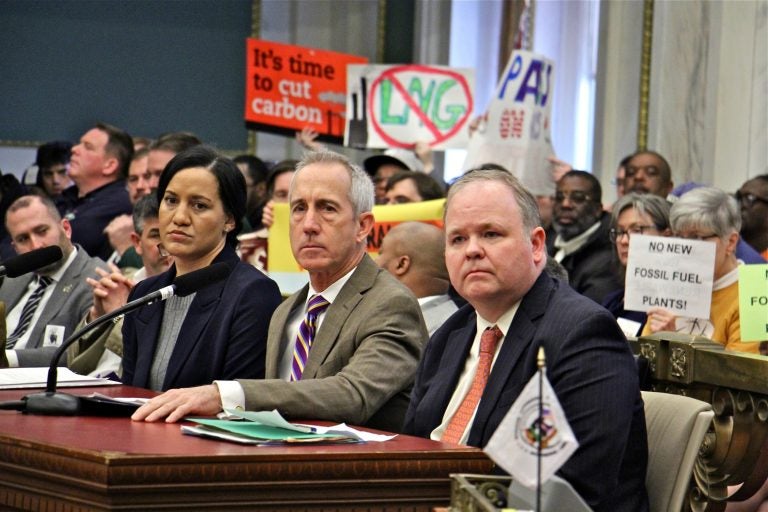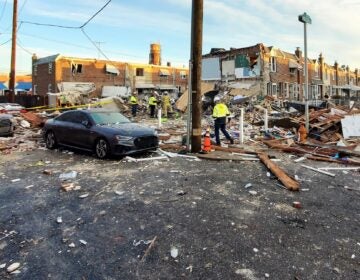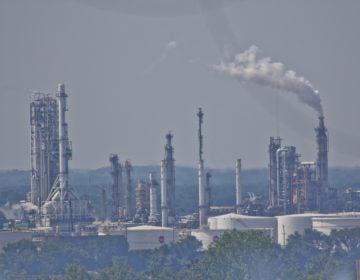PGW wins key city approval for Southwest Philly LNG venture
Philadelphia Gas Works’ planned liquefied natural gas plant won a key approval this week, moving the $60 million Passyunk Energy Center closer to groundbreaking.

Representatives of Philadelphia Gas Works (from left) Melanie McCottry and President and CEO Craig White, and Matthew Tayler of Liberty Energy Trust, testify before the Committee on Transportation and Public Utilities while opponents raise signs in protest. (Emma Lee/WHYY)
This article originally appeared on PlanPhilly.
—
Philadelphia Gas Works’ plan for a liquefied natural gas production facility won a key approval this week, moving the $60 million Passyunk Energy Center closer to groundbreaking.
The proposal now needs only a final vote by City Council, which is expected by the end of March.
Passyunk Energy Center will be built on PGW property, but entirely financed by Liberty Energy Trust, a Conshohocken company. Liberty will pay the city-owned utility annual fees and profits of at least $1.35 million. PGW and the gas commission have said the revenue would help reduce the need to raise customer rates.
The LNG venture has stoked debate since it was first announced in September. Emily Schapira, the executive director of the Philadelphia Energy Authority, which promotes renewable energy projects for the city, says if the PGW project’s main goal is to keep energy affordable, a more effective approach would be investing in home repairs for energy efficiency.
But she says the LNG facility won’t increase carbon emissions. In fact, she says it would reduce carbon emissions, based on an environmental review commissioned by PGW.
LNG is created by cooling methane to -260 degrees Fahrenheit. The process is energy intensive but useful because LNG is easier to store and transport than natural gas in other forms.
The LNG made at PGW’s South Philadelphia facility would be sold as backup power to institutions that now use diesel. Gas burns cleaner than diesel or coal — a point made by project supporters at Wednesday’s hearing.
Chris Pulchasky, director of policy and strategic initiatives at the Mayor’s Office of Transportation, Infrastructure and Sustainability (OTIS), said that the project could actually reduce particulate matter, nitrogen oxides and sulphur oxides, according to a study done by PGW.
“It is also estimated that the project will reduce carbon dioxide by 133,688 tons annually,” Puchalsky said.
But the Clean Air Council’s Matt Walker says that PGW’s plan runs counter to the city’s commitment to tackle climate change. He says the city should focus elsewhere when it comes to meeting its climate goals.
“If the city is serious about reducing diesel exhaust from sources in the city, it should consider policies that specifically target pollution sources in the city that use diesel fuel,” he testified.
Walker says the city’s sole focus should be on developing renewables.
Christina Simeone, policy director for the Kleinman Center for Energy Policy at the University of Pennsylvania, says the project is a responsible way for PGW to generate revenue using its LNG assets. The extra revenue stream, a minimum of $1.35 million per year, will benefit its customers and avoid rate increases. But she stresses that the plan could be risky.
“LNG for locomotive transport is essentially still in pilot phase,” Simeone said. “Displacing diesel through LNG for backup generation requires a big upfront investment, because you can’t use gas in an existing diesel generator and you need LNG storage and vaporization on-site. These upfront investments may be cost prohibitive.”
But if the project is successful, replacing diesel with natural gas power can benefit the environment and public health.
Editors Note: This article has been updated throughout.
WHYY is your source for fact-based, in-depth journalism and information. As a nonprofit organization, we rely on financial support from readers like you. Please give today.







